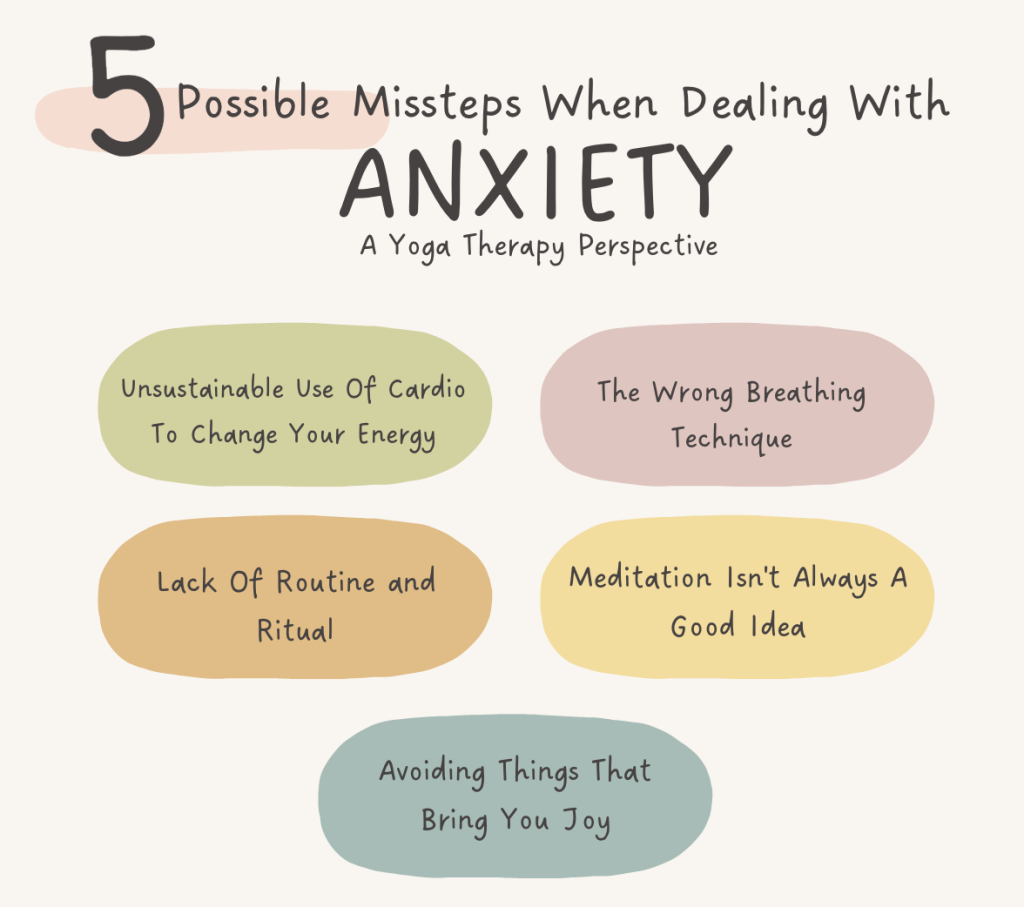A Yoga Therapy Perspective

As a Yoga Therapist, I use the kosha model to work with anxiety. Essentially, I look at all five koshas (or sheaths around the true self) when assessing my clients: body, energy, mind, subconscious, and the ability to experience joy. From there, I give them practices to balance these koshas.
Let’s take a look at anxiety through the koshas and see what common missteps those suffering with anxiety often make:
1) Your Body: Most health professionals recommend exercise for coping with anxiety, and many people use intense cardio to “take the edge off” their anxiety. Basically, they push themselves to exhaustion to feel a big drop in mind activity and energy. Unfortunately, that all or nothing approach is unsustainable both physically and mentally. Learning to move and breathe in gentle ways that systematically decrease your energy can be much more accessible and sustainable.
2) Your Breath: If you suffer from anxiety, you have most likely been told breathing can help. However, not all breathing techniques are the same, especially in the yoga world. Common techniques like kapalabhati, or breathing that emphasizes the inhale, actually increases your energy, often making anxiety worse. There are a number of breathing techniques that can easily decrease energy and a good yoga therapist can teach you those.
3) Your Mind: All your mind really wants to know is exactly “What’s Next?” Fear of the unknown is at the root of many people’s anxiety. So, having a wide open schedule, consuming random (and scary) information on the internet, and lacking rituals in your daily activities and personal interactions is the opposite of what your mind really needs. I often work with my clients on daily schedules and simple mantras that offer a soothing rhythm for their minds.
4) Your Subconscious: If you are suffering from intense anxiety, meditation might actually be a BAD idea. Don’t get me wrong: meditation is amazing. But the mistake people often make is they think all meditations will calm them down. If you have intense anxiety and are new to meditation, it can be nearly impossible to have a useful meditation experience. First, you need to do the other 3 things above! Then, once you reduce your symptoms and suffering, you can do the proper meditations to ultimately untie your subconscious wiring in the long term.
5) Your Ability To Feel Joy: As with any chronic condition, experiencing joy is a game changer. Unfortunately with anxiety, many people don’t do the things that ultimately make them joyful: hobbies, spending time with friends, traveling, etc. There are yoga techniques to experience joy and connect with yourself and others: yoga nidra, lovingkindness practices, or simply being a part of a yoga community! A yoga therapist can help you try these things and experience your bliss.
If you’re ready to heal and find relief from your suffering, please reach out to me and set up a private yoga therapy session in-person or online.
– Joe Simek

Joe Simek is an Internationally Certified Yoga Therapist (C-IAYT 875-Hours), a 500-Hour Level Yoga Teacher, and co-owner of Dragonfly Yoga. He has been practicing yoga for more than a decade, using the wisdom of the teachings to lose weight, get sober, and abandon the corporate grind.
Joe has completed over a thousand hours of yoga training. He studied Yoga Therapy (including 150 clinic hours) and Peaceful Weight Loss Through Yoga at Breathing Deeply Yoga Therapy with Brandt Passalaqua. He also studied Advanced Vinyasa Yoga with Rolf Gates. Since 2017, Joe has been a Yoga Therapy Teaching Assistant at Breathing Deeply, where he is also the lead teacher for their 200-Hour Teacher Training Program.
In 2016, Joe co-founded The Fiaria Project, a non-profit organization that aids foster children. Joe holds a Bachelor of Arts in Journalism from Arizona State University.
